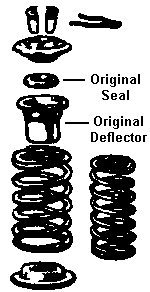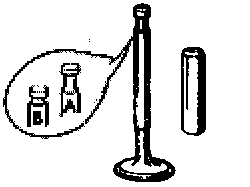The MGA With An Attitude
VALVE STEMS and Hardware, Type A and B - CH-110

At 11:47 AM 2/7/2007 -0500, Bob Howard wrote:
"How does one differentiate type A from type B rocker mechanicals?"
This is not a difference of the rockers, it is a difference in valve stems and keepers (cotters) and spring caps. See illustration at right. Type A valves have the wide "rectangular" keeper groove. These were used in all MGA and MGB engines through the 1800 GB series (first 5-main) through 1967, and also about 10% of the way through GF engine production for 1968 model (Nov 1967 change of the valve parts). The type B valves have the smaller "round" keeper groove. These were used from mid GF engine production in November 1967 to end of production in 1980.
|
 It is common for earlier heads to be converted to the later type B valve hardware parts. Some time ago I installed alloy spring caps on one of my MGA engines (with early 18 head). These parts were available only for the type B cotters, so all valves and cotters and spring caps were changed at the same time.
It is common for earlier heads to be converted to the later type B valve hardware parts. Some time ago I installed alloy spring caps on one of my MGA engines (with early 18 head). These parts were available only for the type B cotters, so all valves and cotters and spring caps were changed at the same time.
There are additional changes of valve gear. The oil deflectors were eliminated early in 18G engine production. At that time the spring cap changed the pilot dimensions for the inner spring. The oil deflector cannot be used with later spring caps. Currently available new replacement spring caps will be the later type. If you want to use the oil deflectors you need to source the earlier spring caps as good used parts. Oil deflectors cannot be used with any of the type B spring caps.
|
At some point in MGB production the rocker arm and adjuster screw changed, eliminating the extended oil feed hole in the arm and screw. New replacement rocker arms and screws will most likely be the later type. If you want to have the oil feed through the adjuster screw to the top of the pushrod you may need to source good used parts there as well.
At beginning of 18V engine production (1972 model) the engine changed to single valve springs (cost reduction) with longer pushrods and short hollow bucket tappets for reduced mass of the valve train. The spring cap also changed, no longer machined to accommodate the inner valve spring. Cam drive sprockets and timing chain changed to single row chain at the same time (also cost reduction).
For a performance engine it is common to use the earlier double row timing chain and sprockets, earlier dual valve springs and related parts, later 18V type light tappets and longer pushrods (and maybe also alloy spring caps for very high revving engines). Using the light tappets and dual valve springs the engine can rev to 7000 rpm without valve float. With addition of alloy spring caps, at least 7500 rpm (probably higher) without valve float. If you install a performance camshaft (especially with increased valve lift) or high ratio rocker arms (to increase valve lift) you will need to use up rated (heavy duty) valve springs to prevent valve float over 6000 rpm.
|

 It is common for earlier heads to be converted to the later type B valve hardware parts. Some time ago I installed alloy spring caps on one of my MGA engines (with early 18 head). These parts were available only for the type B cotters, so all valves and cotters and spring caps were changed at the same time.
It is common for earlier heads to be converted to the later type B valve hardware parts. Some time ago I installed alloy spring caps on one of my MGA engines (with early 18 head). These parts were available only for the type B cotters, so all valves and cotters and spring caps were changed at the same time.